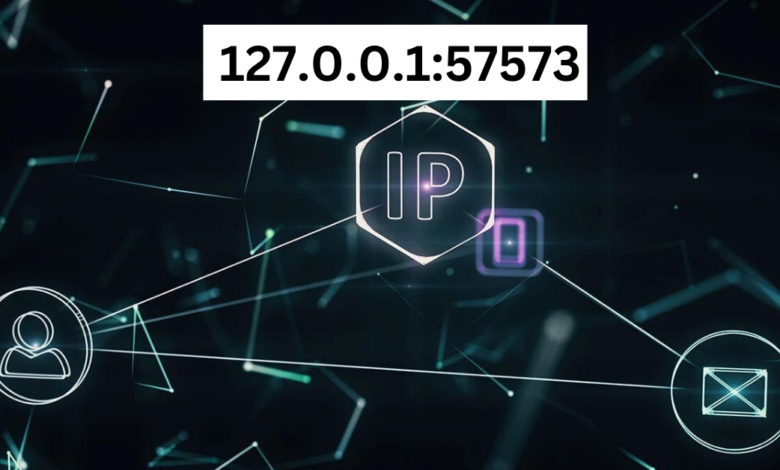Understanding “127.0.0.1:57573”: Understanding Localhost and Port Numbers: A Basic Guide

Introduction to 127. 0. 0. 1:57573
On first glance, when one looks at the string of characters ‘127.0.0.1:57573’ the thought process that precedes the reading of them would likely look no different from when one is faced with any other random string of numbers and dots. But in fact this string has great significance in the sphere of computing. To explain it in simple terms, “127. 0. 0. 1” is an IP address that leads to the computer which you are using at the moment. The “:“57573” part represents a port number; that is, it is a ‘door’ that the various forms and types of network traffic utilize when coming into and going out of your computer. Alone, “127.0.0.1:57573” points to a port on the LocalHost which is your machine. In this article we will introduce what this combination is, why it is used and how you can use it in many computing operations.
The term “127.0.0.1” is used quite frequently in the discussions on networking and development where developers explore a new program and configuration of local servers. This is because directly translated “127.0 0.1” is an IP address connected with one’s loopback network interface within the computer. Basically, it is a process through which your computer can talk to the other part of the same machine. This can be very useful for such things as test and development since it enables you to install and test a web server on your machine and manipulate it in a way that would be possible online.
The second parameter is barely more arbitrary: the port number is “57573.” I got to know that ports are endpoints for applications, and several services can be hosted on a single IP. Adding a port number like ‘57573’, means that the traffic needs to be given to a specific application on your computer. This can be applied especially in development contexts since there could be several services that have to be run at the same time but cannot influence one another.
The Role of 127.0. 0.1 in Networking
In order to analyze the meaning of the phrase, “127.0.0.1:57573” it is necessary to understand the essential meaning of “127. 0.0.1”. Also referred to as the “loopback” address, “127.0.0.1” is one that is used by a computer to give back network traffic to that same computer. It’s an intentionally assigned IP address that is primarily used in diagnostic and configuration of the network issues. If you use IP address “127.0.0.1,” your computer does not dispatch the traffic through physical interface but instead, it IS routed internally. This will assist the developer, for instance, to test network applications without having to engage an active internet connection.
For instance, let us consider a developer who is working on a web application; he or she will most likely develop the application and then run it locally before having it pushed to a live environment. This way they’re able to test how the application will fare in real life situations without having to spread whatever it is they’re testing out across the internet: just use the “127.0.0.1” address. This reduces the possibility of allowing several half baked or sensitive applications to be put on the WWW. In addition, it enables developers to work at a confined space where adjustments are possible with a resulting demonstration on the fruits of their work within a short span of time.
Furthermore, “127.0.0.1” is used in many system operations and the processes. Some services of the system may use loopback address to provide internal interactions with other services of the system. For instance, a database server running on the device of slightly interpretation and lower SOCK can use ‘127.0.0.1’ to connect with the local web server. This sort of setup is used whereby the development process involves as many factors as possible that are present in the production environment although the application is not deployed to the internet fully.

Understanding Port Numbers: What Does :57573 Mean?
“57573” in “127. 0. 0. 1:57573” indicates to a number of port. In networking a port refers to an identifier of a network connection or node for the purpose of handling communication over the network. While “127. 0. 0. 1” directs traffic to your own computer, “:This action says to the computer, “Please go handle this traffic with this protocol or service, ‘57573’.” The usage of port numbers is important; some of them have predefined usage all over the world while others are assigned to free usage.
Port numbers range from 0 to 65535 and are divided into three categories: the first one is the well-known ports with numbers between 0 and 1023, the second one is the registered ports, which numbers are between 1024 and 49151, the last one is the dynamic or private ports to which numbers are greater than 49152. Analyzing the port “57573”, it is possible to define that it belongs to the dynamic range, thus, it meets the most various custom applications and temporary connections. Port numbers in this range usually do not conflict with other services and applications, that is why developers prefer to use it when setting up their local development environment.
So when you use a port number say “57573”, you are instructing your computer to forward the traffic to an application that is listening on that port number. This is important more so in web development and testing since you get a chance to work with many services in the same host without complications. For instance, you might have a web server is running on “http://127. 0. 0. 1:8000” while the database server is running on “http://127.0.0.1:5432. ” Thus by using different ports, one can avoid confusion between one service and the other.
Practical Applications of 127.0.0.1:57573
Therefore, you may ask that why one can see only “127.0.0.1:57573”? They are popular when one is creating a new local server environment or testing environment by a developer or IT professional. By choosing a number such as “57573” as the port number they ensure that there is a low likelihood of port conflict. This also favors test and development processes as several services can be run concurrently to pass the application without impairing others.
For instance, let me assume that you are working on a new web application in which you need a Web server and a backend service to be active at the same time. So you may have your web server listening on “127.0.0.1:8080” and your backend service on “127.0.0.1:57573. ” It is beneficial to keep each service separated in such a manner because debugging such applications can be quite a painful process and having all the services integrated only makes it worse.
Moreover, applying “127.0.0.1:57573” will also can help to increase security in some cases. As this address refers to your own computer it is unreachable from the internet, that is why. This means that any services that start on “127.0.0.1:57573” are in fact protected from external insecurity. This can of course be especially useful when processing sensitive information or when running proprietary applications which should not fall under attack.
How to Use 127.0.0.1:57573 in Your Projects
To many system administrators, “ ”127.0.0.1:57573” when used in your projects shouldn’t be challenging ta very hard to understand but … First, use the netstat tool to check that information, and second, make sure that whichever service you plan to run on this port will listen “127.0.0.1 : <port number>”. This is usually done through adjusting configuration files or by applying command line parameters regarding IP address and port number.
After that to test your service open a web browser or terminal and type ‘127.0.0.1:57573. ‘ If your configuration worked your application or service should be up and running. This setup assists in the development of an application by providing a permissible environment to work on the application locally, without the requirement of internet connection and connections to other networks.
I would also like to pointed that fact, that use “127.0.0.1:57573” for developing or testing – cool but for production – no. In production, your services must pay attention to socket IPs/addresses and socket ports that are permissible on the internet. But as with the ability to use “127.0.0.1:57573” in a local environment, having to adapt the application to live servers will not pose a challenge.
Conclusion
“127.0.0.1:57573” may appear as a number sequence, but it has a complex value when it comes to the system of networking and software engineering. But it’s also important to know how to leverage it – if done correctly, this allows you to construct powerful, safe local environments for testing and development or even problem solving with the help of debugging. For the experienced developer or the new one who wants to develop a new application or improve on the existing ones, understanding the ways to use “127.0.0.1:57573” will boost the competency in developing good applications. As always, while it is a very powerful tool for local development, never forget to secure when you’re moving to production.





